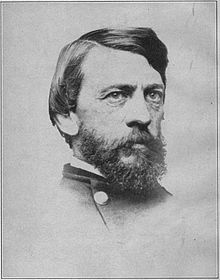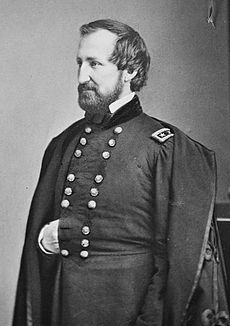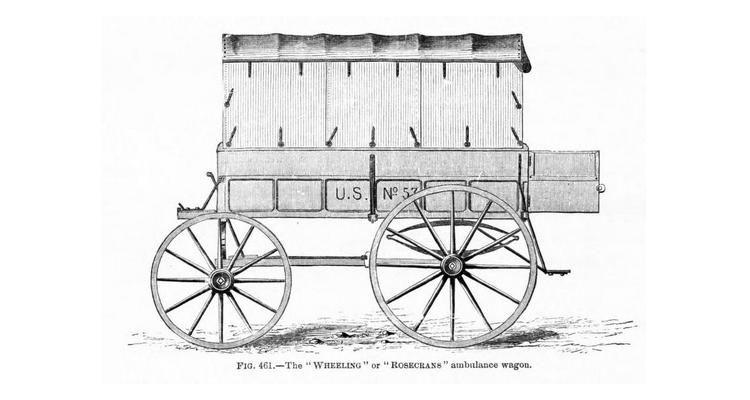Even though no battles were fought here, Wheeling was an important site during the American Civil War.
Camp Carlisle on Wheeling Island provided training for Union soldiers, and the Atheneum on Market and 16th streets housed federal prisoners. Of course, Wheeling became the capital of the newly minted state of West Virginia during the war as well, which made Wheeling an important asset for the Union Army.
Wheeling also contributed to the survival of thousands of wounded troops after an ambulance was designed and built here during the early months of the war. Known as the Wheeling, or Rosecrans ambulance, the horse-drawn carriage hauled injured soldiers off the battlefields to life-saving medics and became the most used ambulance of the Civil War.
Ambulances did not become part of the United States military until a few years before the Civil War. Soldiers and the people who treated them knew they were losing lives with no reliable means of quickly and safely removing injured persons from the battlefields. In the early months of the Civil War, ambulances were poorly designed and operated by untrained drivers. All that changed through the efforts of a surgeon, a general, and some wagon builders from Wheeling, [West] Virginia.

Major Jonathan Letterman, who was later known as the “Father of Battlefield Medicine,” was born and raised in Cannonsburg, Pa., and educated at Jefferson College, which later combined with Washington College to form Washington & Jefferson College. He earned his degree at Jefferson Medical School in Philadelphia. At the start of the Civil War, the already-experienced medic served in the Army of the Potomac. In May 1862, he was named medical director of the Department of West Virginia. Just a month later, Letterman was appointed medical director of the entire Army of the Potomac. He began organizing the medical service and was given carte blanche to do what was needed to decrease battlefield casualties. By 1864, Letterman’s battlefield medical practices were standard across the entire Union Army.Letterman knew that changes had to be made. He created the Ambulance Corp for the Union Army. This group of soldiers was trained to load patients safely onto gurneys and drive the ambulances expertly over rough battlefield terrain. In addition, Letterman had created a system of triage that helped surgeons assess the severity of injuries and treat the men accordingly. Under Letterman’s direction, thousands of Union lives were saved. Although the Confederate Army had ambulances, they did not have Letterman’s systematic approach to battlefield medicine.

Many different styles of ambulances were used in the first part of the Civil War, but they had their share of issues. Some were too heavy. Others required more than two horses to pull them. Still, others were capable of transporting just a few men. General William S. Rosecrans, who was stationed in Wheeling during the First Campaign of the Civil War, would join forces with Letterman to create what would become known as the Wheeling, or Rosecrans Ambulance. He and his family lived in Centre Wheeling from December 1861 to March 1862 while he commanded the Department of West Virginia from his headquarters at 75 12th St.. (A building that remains standing.)
Like Letterman, Rosecrans knew that ambulances needed improvement. Letterman’s medical knowledge and Rosecrans’ engineering background came together to design what became known as the Wheeling, or Rosecrans ambulance. Built in Wheeling, the ambulance helped transform survival rates for Union soldiers hurt in battle.
The Wheeling Ambulance was superior to the ambulances that came before it because of it was light weight (750 pounds), could be pulled by only two horses and could carry 11 or 12 men in seated positions. Letterman and Rosecrans designed it so that the seats and beds could be raised and lowered to accommodate two to four patients in recumbent positions. The Wheeling Ambulance also carried five gallons of water, medical supplies and other necessary equipment. In addition, the springs reduced the jarring of ailing bodies as the ambulance trundled over rutted battlefields. The Wheeling ambulance with additional modifications would be used into the 20th century when motorized ambulances took over.
Visit the Pry Field Hospital Museum, via this YouTube video, to see a reconstruction of a Civil War ambulance.
The Wheeling ambulance was designed by Letterman and Rosecrans while they were stationed in Wheeling and manufactured by Busbey, Little, Hays & Company, acclaimed Wheeling wagon and carriage builders. The Wheeling Ambulance was put to the test on a big scale at the Battle of Antietam in September 1862. It was the bloodiest one-day battle of the Civil War. The Wheeling ambulance and Letterman’s evacuation plan and triage methods meant that all bodies were removed from the battlefield within 24 hours of its end.
Locally, the Wheeling Ambulance was used to transport patients from nearby battlefields and from riverboats to Wheeling Hospital. Given Wheeling’s location, the hospital saw more than its share of wounded Union and Confederate soldiers. Founded in 1850, the hospital was staffed by the Sisters of St. Joseph starting in 1853. The entire hospital was taken over by the Union Army to care for wounded soldiers in July 1864, and the Sisters became Army nurses. On July 6 of that year, 200 injured soldiers arrived unexpectedly, and the Sisters gave up their beds to accommodate the ailing men. They slept on the floor of the chapel and worked around the clock to ensure their care.
The Wheeling Ambulance remains a celebrated hero of the American Civil War. Rayland, Ohio, residents, John Marko and his son, Joe, built a replica of the Wheeling Ambulance over a two-year period from 2002 to 2004. The Markos stated that they modeled their ambulance after the photo of the original that hangs in the lobby of Wheeling Hospital. John Marko served in the United States Army from 1954-1957. His love for woodworking led him to create the replica out of found materials.
Historians are impressed by the reproduction. It has been part of many different exhibits, including the 150th anniversary of the Battle of Antietam. It also visited Wheeling during a lecture on Civil War medicine at West Virginia Independence Hall in 2005.
Wheeling, West Virginia has been the site of many incredible innovations, and the home of a number of astounding innovators. The Wheeling Ambulance is part of that tradition. Without the Wheeling Ambulance and battlefield medical practices developed by Letterman, far more soldiers would have died during the bloodiest war on United States soil. And Wheeling laborers were part of it all.
• Christina Fisanick, Ph.D., is an associate professor of English at California University of Pennsylvania, where she teaches expository writing, creative non-fiction and digital storytelling. She is the author of more than 30 books, including her most recent memoir, “The Optimistic Food Addict: Recovering from Binge Eating Disorder” http://amzn.to/2HCgZmg. She has been a Weelunk contributing writer since 2015. Christina is a 1996 graduate of West Liberty University and a member of Ohio Valley Writers. She lives in Wheeling with her family.




